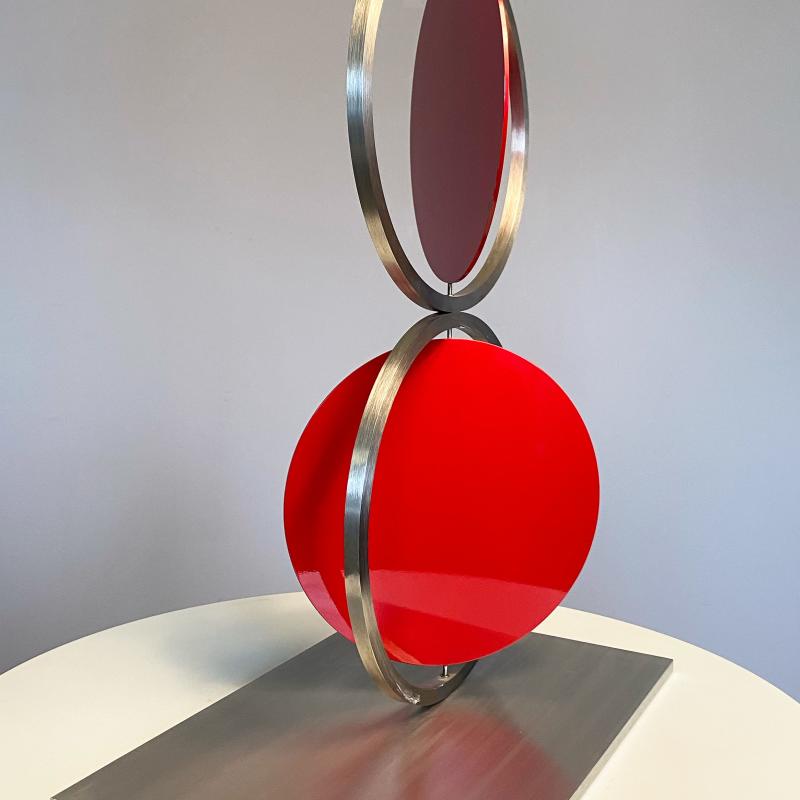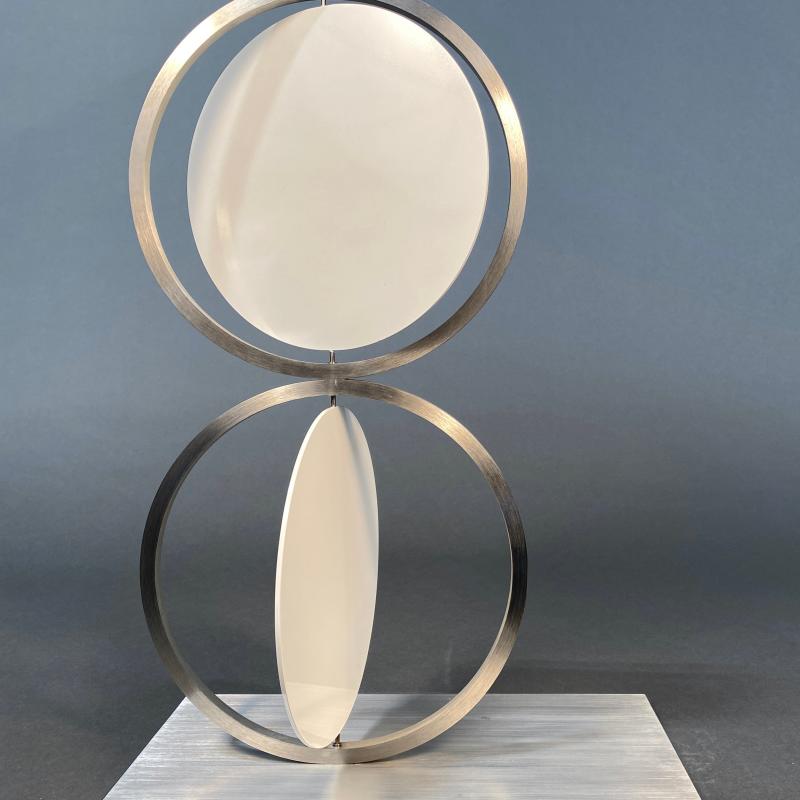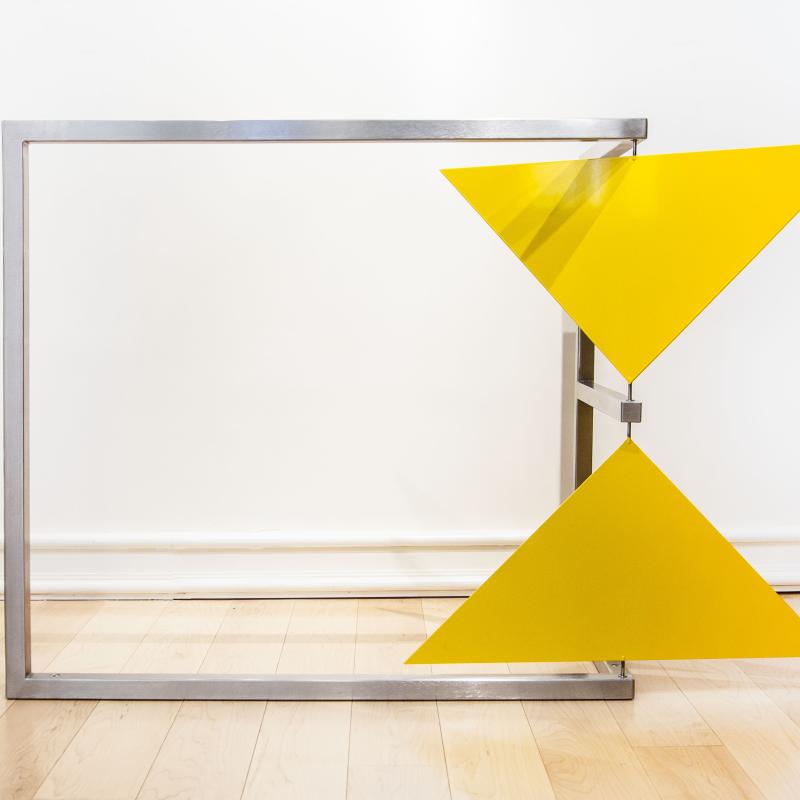-
 Roger PhillipsFigure Eight Red, 2015Steel, aluminum, enamel paint21 x 15 x 10 inchesSigned: Roger Phillips 2015 1/15 / 21 inch Figure 8 (under)
Roger PhillipsFigure Eight Red, 2015Steel, aluminum, enamel paint21 x 15 x 10 inchesSigned: Roger Phillips 2015 1/15 / 21 inch Figure 8 (under)
-
 Roger PhillipsFive Triangles on Rods, 2015Stainless steel and enamel19 3/4 x 36 x 4 inchesSigned: Roger Phillips 2015 2/15 (under)
Roger PhillipsFive Triangles on Rods, 2015Stainless steel and enamel19 3/4 x 36 x 4 inchesSigned: Roger Phillips 2015 2/15 (under)
-
 Roger PhillipsWhite Figure 8, 2015Steel, aluminum, enamel paint21 ½ x 15 x 10 inchesSigned: Roger Phillips / 8/15 / White Figure 8 / 2015 (under)
Roger PhillipsWhite Figure 8, 2015Steel, aluminum, enamel paint21 ½ x 15 x 10 inchesSigned: Roger Phillips / 8/15 / White Figure 8 / 2015 (under)
-
 Roger PhillipsSplit Disc on Two Squares, 2013Enamel, stainless steel and aluminum15 3/4 x 11 1/4 x 7 3/8 inchesSigned: Roger Philips 2013 2/10 (under)
Roger PhillipsSplit Disc on Two Squares, 2013Enamel, stainless steel and aluminum15 3/4 x 11 1/4 x 7 3/8 inchesSigned: Roger Philips 2013 2/10 (under)
-
 Roger PhillipsTriangular Corner, 2005Steel, aluminum, enamel paint34 x 37 1/2 x 18 3/4 inchesSigned: Roger Phillips / 2005 1/5
Roger PhillipsTriangular Corner, 2005Steel, aluminum, enamel paint34 x 37 1/2 x 18 3/4 inchesSigned: Roger Phillips / 2005 1/5
Overview
The following text is reproduced courtesy of independent curator Wendy McDaris (2005):
Roger Phillips was born in New York City in 1930. His education as a metal smith began on Long Island at age 12 as a blacksmith’s helper. He has worked in metal ever since. His first exposure to art was at the Woodstock Country School in Vermont where he studied with Francis Foster, a teacher from Black Mountain College who ran his classes on the Bauhaus model.
Phillips graduated from Bard College in 1953. He studied drawing and design at the New School and metal fabrication at the Jewish Museum in New York. He is a past president of the Artist-Blacksmith’s Association of North America. His studio/workshop is located in Stuyvesant, New York about 100 miles north of New York City.
A constructivist, Phillips is in private and public collections throughout the United States. A large portion of his work is kinetic, made of stainless steel and brightly painted aluminum plate. Many pieces are commissioned for specific outdoor sites. Smaller versions, suitable for the interior of a house, of some of Roger’s sculptures have been produced in limited editions.
The beauty of Roger Phillips’s sculpture is experienced as soon as you see it. Simplicity and purity are achieved through meticulous engineering and craftsmanship. His vision is elegant, positive and decidedly upbeat. His own words reveal the inner spirit of the work.
Several influences are obvious: the bright forms, although more geometric, are reminiscent of Alexander Calder; the smoothness of motion plays homage to George Rickey; and the dialogue between graphic and three dimensional work refers to Ellsworth Kelly.
Various kinetic sculptors use slightly different methods to create motion: in Calder’s work the moving elements are attached from the top, Rickey’s are pendulums, Tim Prentice uses ballast, Lin Emery connects at the bottom and Pedro de Movellan sometimes uses magnets. Each produces a different effect. In contrast, Phillips has the moving elements held at top and bottom so each moves in a 360-degree orbit around a vertical axis.
There is a provocative contrast between the rigidity of the frame and the fluidity of the moving elements. The moving parts seemingly disappear and reappear as they revolve, revealing the surrounding landscape through the negative space. The sculptures appear light and airy as their glossy colored surfaces reflect their natural surroundings.
Phillips’s sculpture recalls Plato’s description of geometric form: “these are not, like other things, beautiful relatively, but always and absolutely.”
Exhibitions
Bard College, Annandale-on-Hudson, New York, 1999, 2004
Carol Craven Gallery, Vineyard Haven, MA.
Chesterwood, Stockbridge, MA, 2002, 2003, 2004, 2005
Hudson Opera House, Hudson, NY, 2000
James Graham & Sons, New York, NY, 2004, 2005
Marisa del Re, New York, NY 1990
Monte Carlo Biennale, Monaco
Monte Carlo Biennale, Monaco, 1991, 1993
Morgan Lehman Gallery, Litchfield, CT 2004
Roche Court, Salisbury, England courtesy of the New Art Centre, London, 1993
Simon Gallery, Morristown, NJ
Weber Fine Art, Scarsdale, NY, Chatham, NY and Greenwich, CT, 2004-2005
Museums and Public Collections
American College, Bryn Mawr, PA
Bard College, Annandale-on-Hudson, NY
Brown Rudnick Berlack Israels, LLP, New York, NY
Egelston Childrenâs Hospital, Emory University, Atlanta, GA
George Washington Carver Houses, 100th Street and Madison Avenue, New York, NY
Goizueta Business School, Emory University, Atlanta, GA
Sarah Lawrence College, Bronxville, NY.
Schiffer Publishing Corp, Atglen, PA
Steinberg Conference Center, Wharton, University of Pennsylvania, Philadelphia, PA